#Countess Anastasia Hendrikova
Text
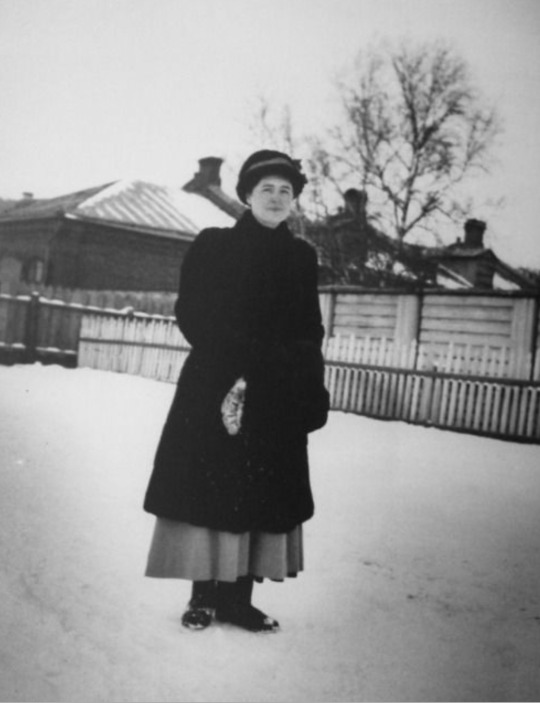

Countess Anastasia “Nastenka” Hendrikova and Catherine Schneider, faithful servants of the Romanov family, Tobolsk 1917-18
The two women were very close friends with Tsarina Alexandra Feodorovna. Catherine taught her sister Ella Russian when she first arrived in the country and did the same with Alix. Nastenka was a long time friend of the family. They faithfully followed the family into captivity from Tsarskoe Selo and to Tobolsk. On their arrival in Yekaterinburg, they were imprisoned and eventually violently executed. They are remembered today as faithful servants that stayed with the family no matter what.
#anastasia hendrikova#nastenka hendrikova#catherine Schneider#tobolsk#tsarskoe selo#yekaterinburg#1917#1918#romanov#romanovs#captivity#house arrest#the governors mansion#countess Anastasia Hendrikova#rare photos
31 notes
·
View notes
Text

Suite members who accompanied the Romanov family to Siberian exile: Prince Vasily Dolgorukov (right) with Countess Anastasia Hendrikova, Pierre Gilliard, Count Ilya Tatishchev and Catherine Schneider. All but Gilliard perished by the Bolshevik hand in 1918.
#Prince Vasily Dolgorukov#Countess Anastasia Hendrikova#Pierre Gilliard#Count Ilya Tatishchev#Catherine Schneider
6 notes
·
View notes
Text
Romanov myths part three - did the Grand Duchesses go shopping?
Over the years, a prevalent belief that the Romanov Grand Duchesses, Olga, Tatiana, Maria, and Anastasia did not go shopping continues to be repeated. Some historians have even suggested that the girls did not know how paying for items worked. However, primary sources from people who knew the girls, were members of their entourage, and the Grand Duchesses' own diaries, tell a different story...
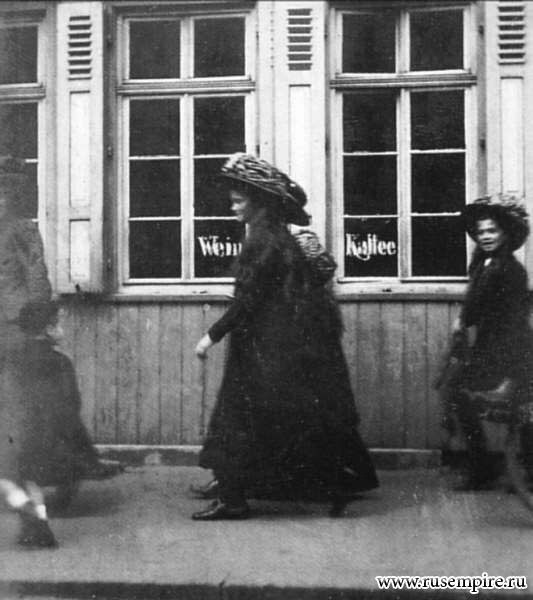
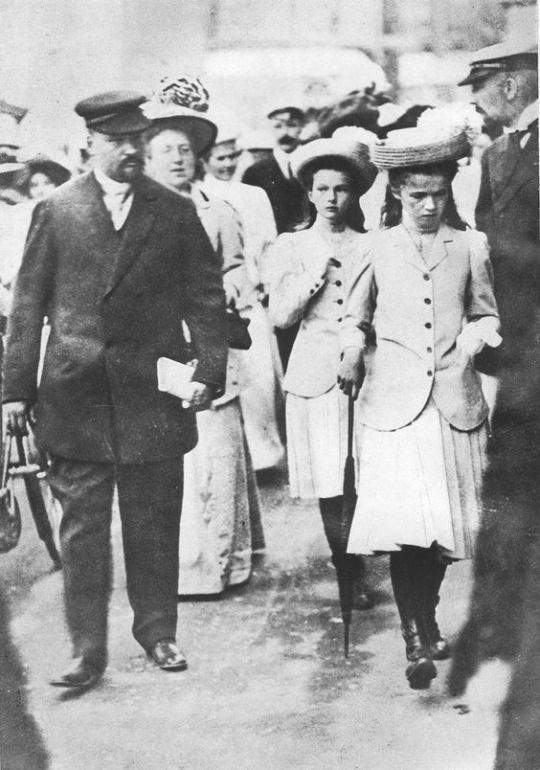
"Saturday. 10 August. … We walked along the historic boulevard and the main streets, but crowds followed us everywhere, so we were able to go into only 2 shops for a minute..."
"Friday. 15 November. Had lessons, after that went shopping for wool with Nastenka as usual.."
From Grand Duchess Olga Nikolaevna’s 1913 diary [my underlining]
In this entry, Olga describes shopping Countess Anastasia 'Nastenka' Vassilievna Hendrikova, who was a young lady-in-waiting at court and a particular favourite of the Grand Duchesses, often accompanying them on trips. As described in the first entry, it appears that safety and security concerns due to crowds, rather than a lack of understanding about shops, contributed to the Grand Duchesses not being able to shop frequently. Nastenka is frequently mentioned by the Grand Duchesses in their diaries, and volunteered to join the Romanov family in their house arrest and imprisonment. She was murdered by the Bolsheviks in September 1918.
"After coffee, I went for a walk with my pupils… They really liked to go to the shops and buy everything. Anastasia Nikolaevna was especially attracted to stores, where they sold doll shoes of various sizes… Tatiana Nikolaevna did not always accompany since the doctors found her heart was weak and she went with the Empress to take baths."
A Few Years Before the Catastrophe by Sofia Ivanovna Tyutcheva.
Sofia Ivanovna Tyutcheva was a maid-of-honour to Tsarina Alexandra Feodorovna, and in 1907 was appointed as governess to the Grand Duchesses. The Grand Duchesses referred to her as "Savanna". She was dismissed in 1912 when she voiced concerns over Grigori Efimovich Rasputin. She wrote a short memoir in 1945, and passed away in 1957.

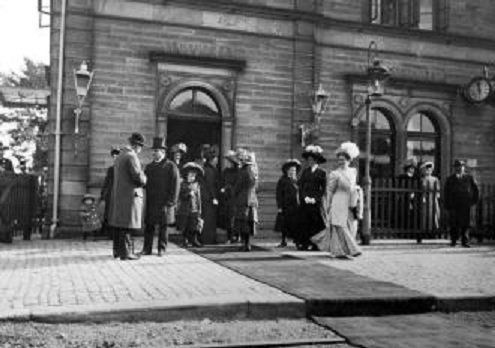
"[The] Grand Duchesses went shopping in the morning with one of the ladies-in-waiting to the Empress. They delighted in that because they could mix with the crowd and buy things just as everyone else did, and they were so pleased if they were not recognised at once." -- Upheaval - Olga Voronova
Countess Olga Konstantinovna Voronova was part of the aristocratic Kleinmichel family and in 1914, married one of the Romanov's favourite officers, Pavel Alexeievich Voronov. Through these connections, Olga Konstantinovna became a friend of the Grand Duchesses, exchanging frequent letters with Olga and Tatiana in particular, before and after the Revolution. She published her memoirs in 1932. Once again, it is inferred that being recognised and subsequent security concerns stifled the Grand Duchesses' shopping sprees.
Where did the myth come from?
It appears that the myth came about due to this extract from Margaretta Eagar, an Irish nanny who cared for the children from 1898 to 1904:
Her only knowledge of shops and shopping was derived from the toy and sweet shops in Darmstadt. One day she asked me why the Americans spoke English, not American. I told her the story of the Pilgrim Fathers, and described how they built houses and shops, and so made towns. She was exceedingly interested and inquired, ' Where did they find the toys to sell in the shops ? "
Six Years at the Russian Court, by Margaretta Eagar
It appears that some historians forgot that Margaretta Eagar moved on from her nanny position in 1904, when the eldest Grand Duchess was nine and the youngest was three, and perhaps did not look for sources from when the Grand Duchesses had grown up and had slightly more independence.
Over time, the myth appears to have been exaggerated and repeated until it became part of the 'folklore' surrounding the Romanov Grand Duchesses.
Whilst it is clear that the Grand Duchesses did enjoy going shopping in their lifetimes, safety and security concerns meant they could not enjoy shopping as frequently as other teenagers may have. In the same way royals today would not be able to go to shops without being recognised, there was a chance that a crowd could gather. Similarly, Olga and Tatiana appear to have shopped more than the younger pair, Maria and Anastasia, likely due to being older in age and therefore having more independence.
Photos:
First set, left: Olga, Anastasia (hidden behind Olga), and Maria Shopping in Germany, 1910. Right: Olga and Tatiana out shopping in the Isle of Wight, 1909, accompanied by Dr. Evgeny Botkin (in the suit)
Second set, left: Tatiana and Maria shopping with Sofia Ivanovna Tyutcheva, circa 1910. Right: The Grand Duchesses and their entourage by shops, most likely taken in Germany, 1910
Sources:
Journal of a Russian Grand Duchess: Complete Annotated 1913 Diary of Olga Romanov, Eldest Daughter of the Last Tsar, translator Helen Azar, (Independently published: 2015)
A Few Years Before the Catastrophe: The Memoirs of Sofia Ivanovna Tyutcheva, translator George Hawkins, (Independently published: 2020)
Upheaval, Olga Voronova (Woronoff), (New York; London: G. P. Putnam's Sons, 1932) -- Free to read online here
Six Years at the Russian Court, Margaretta Eagar, (New York: Charles L. Bowman and Company, 1906) -- Free to read online here
#Romanov#Romanov family#otma#Olga Nikolaevna#Tatiana Nikolaevna#Maria Nikolaevna#Anastasia Nikolaevna#sources#myths#myth-busting#Romanov sisters#Margaret Eagar#Margaretta Eagar#Sofia Ivanovna Tyutcheva#Nastenka Hendrikova#diaries#free to read#Olga Romanov#Tatiana Romanov#Maria Romanov#Anastasia Romanov
84 notes
·
View notes
Text

Grand Duchesses Olga, Maria, and Anastasia Nikolaevna with their father Tsar Nicholas II and Countess Anastasia Hendrikova, 1916.
#romanov family#olga nikolaevna#maria nikolaevna#anastasia nikolaevna#tsar nicholas ii#romanovs#history
17 notes
·
View notes
Photo



Countess Natalia Konstantinovna Kleinmichel "Tata", Countess Olga Konstantinovna Kleinmichel (later Voronov), Countess Anastasia Vasilyevna Hendrikova "Nastenka", Grand Duchess Tatiana Nikolaevna and Grand Duchess Olga Nikolaevna at Anna Alexandrovna Vyrubova's house in Tsarskoe Selo, 10th May 1913.
"Friday. 10 May. Had lessons. Had breakfast and dinner with Mama. Her heart is almost No.2. T. and I rode with Nastenka. [Today] was not as nice as yesterday: 15 degrees in the shade. Very nice and warm. Had tea at Anya's with Countess Kleinmichel, her son, Tata and Olga. After dinner sat with Mama. Papa sent me a telegram, he is very busy. Everything is well, thank God."
Azar, H. (2015) Journal of a Russian Grand Duchess: Complete Annotated 1913 Diary of Olga Romanov, Eldest Daughter of the Last Tsar. p. 115.
Photos from:
Anna Alexandrovna Vyrubova's Album n°2 / page 45 - photos 4,5,6
#1913#Olga Nikolaevna Romanova#Tatiana Nikolaevna Romanova#Natalia Kleinmichel#Olga Kleinmichel#Countess Anastasia Hendrikova#Tsarskoe selo
43 notes
·
View notes
Text




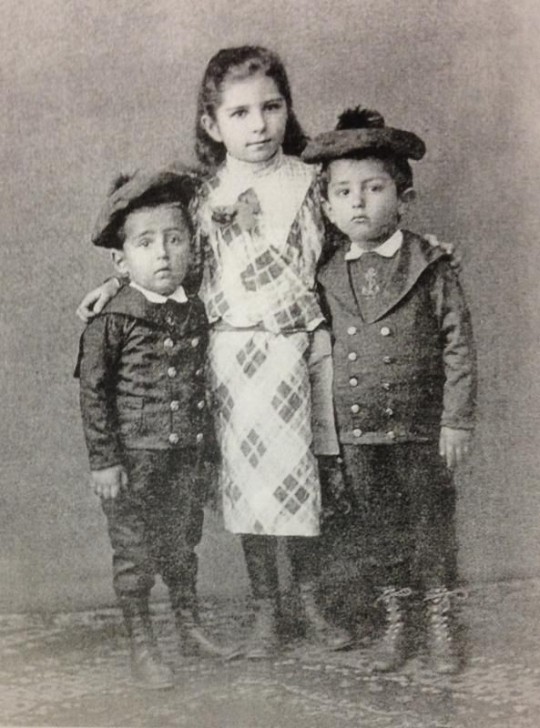
One of my favourite lesser known of the Romanovs was Princess Elena Petrovna Romanova of Russia.Born a Princess of Serbia,she married Prince Ioann Konstantinovich Romanov of Russia.
During the downfall of the Romanov Dynasty,Elena accompanied her husband voluntarily to his exile in Alapayevsk,but Ioann persuaded her to leave Alapaevsk and go back to their two young children, whom she had left with Ioann's mother, Grand Duchess Elizaveta Mavrikievna Romanova of Russia.
She had a "safe conduct" pass signed by Trotsky it was decided that she should go find the children and return as a family; despite the pass the local Commissar only allowed her to go to Yekaterinburg to appeal to the head of the Soviet there.She was reluctant still to leave her husband and when she went to leave she was so upset the guards allowed the prisoners to come out to wave goodbye; the sight of all of them lined up struck her with an overwhelming fear and shouted for the driver to stop but the family turned and went in after giving her encouraging signals;Elena thus went on
She was then on her own to travel and faced several dangers and intimidating situations.
In June 1918, Elena visited the Ipatiev House and demanded to see the Tsar, secretly hoping to pass on letters to the Imperial family from their relatives.
Elena identified herself as the wife of an interned Romanov but also as the daughter of the King of Serbia; the commander was taken aback but refused entry but agreed to pass a message to the Tsar.
After being refused entry, she went to the Amerikanskaya Hotel, making repeated enquiries to the Cheka. She was however arrested by the secret police and she was imprisoned in Perm.
Probably because by now her situation was known and the Serbs were making noises Elena was given her pass to Petrograd; the head of the Serb mission was at her hotel to greet her and gather the children and Elena and take them to Murmansk but Elena was determined to return to Alapayevsk and Ioann; she would accept his help as far as Petrograd but announced she would not leave Russia without Ioann
The group boarded a train but the Bolsheviks uncoupled their carriage and surrounded it and they were taken prisoner on Alexander Georgiyevich
Beloborodov's orders; she was separated from the Serb diplomat and taken to Yakov Mikhailovich Yurovsky where she was strip-searched and locked in a room.
After 2 weeks Elena was told the Alapayevsk prisoners had been set free and the White Army was approaching; little did Elena know her husband and relatives had been murdered
Yakov Yurovsky then ordered Elena to dress to go 'to Moscow' but they drove out to a forest where Elena was sure she'd be shot in reprisal for the prisoners' 'escape' but they entered a clearing where a train waited; the Bolsheviks were taking hostages to protect them from the Whites; the party of a few dozen included Mr Atamamnoff and the Serb diplomat; Helen was stunned to see that the only women in the group were Countess Anastasia Vasilievna Hendrikova and Catherine Alphonovna Schneider who had accompanied the Imperial Family and who had been imprisoned since their arrival; the hostages were herded onto the train which headed to Perm where they walked to the prison and the 3 were placed in one cell
They soon heard of the Imperial Family's fate and after a few weeks the guards came for Hendrikova and Schneider who were then shot; Elena was now alone and she was soon moved to a cell with 12 female criminals who were mostly prostitutes who'd killed lovers, husbands or for money; things started off badly but Helen eventually made friends with some and promised to help them rebuild their lives if they survived; Elena spent 5 months in total in the cell; because no one knew precisely were she was she was believed dead and her father began mourning
In December the Norwegian ambassador (who helped as representative of a neutral country) found her ; the guards came for Elena who was sure this was the end but they informed her she would be given a diplomatic passport to leave Russia.
When she reached Moscow though she wasn't taken to the Norwegian consulate but rather to Lubianka prison; the man in charge was known for his cruelty but he actually treated Elena fairly well; he didn't confirm the Alapayevsk deaths but did those of the Imperial Family, he promised to find out about her children and did--reporting they were in Sweden; Elena was supposed to be kept under guard in the prison but Peters obtained rooms for her in the Kremlin; she was given a good meal but her system was so abused that she couldn't eat it and instead gave it to a guard who'd served with her father-in-law.
Soon Peters gave her the news that she could leave the next evening but had to be off Russian soil within 48 hours; the Norwegian ambassador told her to go to the Consulate and gave her papers to leave; the ambassador and his wife were leaving as well and accompanied Elena to Finland; as she was leaving she got a huge shock when Peters' assistant arrived with a huge bouquet of flowers and a note of apology for his not being able to see
As they reached the Finnish border they had to get out and walk as the bridge was destroyed; just short of the border Elena was stopped and said she couldn't leave; Elena began to panic but Mr Kristianson (the ambassador) gave the guard a hefty bribe and, with one last glimpse back at her adopted homeland,Elena left Russia forever; by the next day she was in Stockholm where Prince Schakovskoi (her brothers-in-law former ADC) was waiting to take her to her children; on the way he suddenly blurted out that her husband had been killed with the others which was the first Elena had heard this; her reunion with her children was strained as they barely recognized her but she saw in them her husband and their legacy
She went to Paris with the children where her brother Alexander was waiting to take her to Belgrade where she was reunited with her much-relieved father but settling permanently in Serbia was too painful of her as it reminded her of happier times so Alexander bought her a villa in the south of France where she recuperated before moving to England with her children who were educated there; she later returned to France where she died in Nice in 1962.
41 notes
·
View notes
Photo

Nicholas II with his children, 1913
Left to right: Maria Nikolaevna, Olga Nikolaevna, Tatiana Nikolaevna, Alexei Nikolaevich, Nicholas II, Anastasia Nikolaevna
“At 10 1/2 [we] went to the regimental church for obednya. Otetz Alexander Vasiliev served. After [we] returned, had breakfast with Papa and Sergei T. Mama did not get up yet, because she has a severe headache and is tired. At 2 o’cl. 15 min. we four walked with Papa. Almost no snow at all, but it is 5 deg.[rees] below [zero]. At 3 1/2 o’clock Papa went to the Grand Palace to receive the escort and diplomats, while we went to see Countess Hendrikova. Sat with her for a while, and then went to [see] Aunt Mops, and from there to Anya's. N.P. was there. We had tea all together, it was awfully cozy.
Returned at 5 o’cl.[ock], Mama was lying down on the sofa in her study. It was very dark there and I think she was sleeping. Papa returned after 5 o’cl. and we had tea together. He went to Grandmama’s in Petersburg for dinner. We four had dinner with Anya and Mama in the mauve room. She still has a headache, and heart No. 2. After dinner she was lying down on the sofa there, and we sat near by on the floor and worked. Prayed with Alexei as usual at 8 o’cl. Went to bed at 10 o’cl. The year started out well – no one knows how it will end. Oh Lord, save Papa, Mama and all.”
- Olga’s diary, 1st/14th January 1913
“In the morning we four drove to obednya at the upper regimental church with Papa. Batushka gave a very good service. Had breakfast together with Papa and Sergei. Mama was in bed with a very severe headache. We four walked around our garden with Papa. Returned, changed and the four of us alone went to Countess Hendrikova. She was lying down in bed in the bedroom. We sat there for a little while, then from there to Aunt Evgenia Maksimilianovna’s, from there to Anya’s, Nik.[olai] Pav.[lovich] Sablin was there. There we had tea for a little while, then, when we were leaving on the train we ran into an officer from Mama’s Crimean regiment who taught at the Cavalier Guard School. I was very glad to see N.P.
At this time Papa is at the Grand Palace receiving the suite and diplomats. Had tea with Papa and Mama. Mama got out [of bed] and is lying down on the sofa. Later went to the hall with Alexei, where he slid down the hill with Derevenko’s sons. Then went upstairs where I sat with the sisters. They worked and I read to myself. The, had dinner with Mama, the sisters, and Anya. Papa went to Grandmama’s in Petersburg. After dinner sat and read. At 10 o’cl. Olga and I went to bed.”
- Tatiana’s diary, 1st/14th January
#trans: helen azar#olga nikolaevna#tatiana nikolaevna#olga diary entry#tatiana diary entry#nicholas ii#maria nikolaevna#alexei nikolaevich#anastasia nikolaevna#1913#1910s#romanov#romanovs#otma#otmaa#the big pair
56 notes
·
View notes
Photo
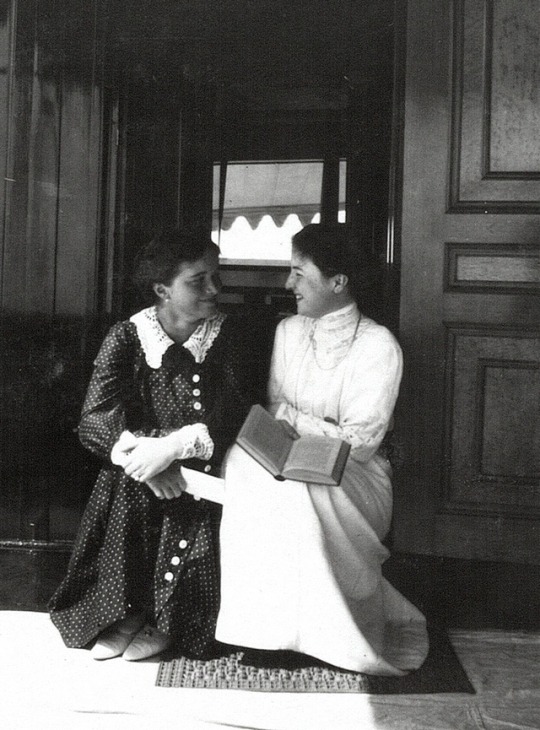
Grand Duchess Olga Nikolaevna sharing a happy moment with Countess Anastasia “Nastenka” Hendrikova
ГА РФ ф. 673 оп. 1 д. 232 л. 21 фото 355 (source)
243 notes
·
View notes
Photo

The Grand Duchesses Tatiana and Maria Nikolaevna Romanova of Russia with Countess Anastasia Vasilyevna Hendrikova and Princess Olga Konstantinovna Orlova.
5 notes
·
View notes
Note
if you could save only one person during the russian revolution, who would it be?
this is tough.
I want to say NAOTMAA but they are 7 people and you only said one. I would never pick just one person out of them to be saved because they would be so traumatized without their family which was their lifeline. I’m also thinking about Elisabeth Feodorovna but I would also think that she would be really terribly heartbroken over her family’s death. I’m glad that she never found out before she died because that would’ve been painful (she died a day after NAOTMAA)
my final answer would be either Cointess Anastasia Hendrikova or Igor Konstantinovich.
Anastasia Hendrikova was a faithful servant to NAOTMAA and sadly was murdered by the Bolsheviks on September 4th 1918. She was so young and I just really wish that she could’ve lived because she was a very close friend to the girls and Alix and I would love to hear her memories of them and to watch her grow up more.
Igor Konstantinovich was the son of Grand Duke Konstantin Konstantinovich who was 2nd cousins to Tsar Nicholas II making Ioann 3rd cousins to OTMAA. The reason I would choose him is because he was extremely young when he was murdered at Alapaevsk on July 18th 1918. He had a full life ahead of him and was an extremely kind soul.
Thank you for torturing me with this hard question anon! (Joke haha 😩)
2 notes
·
View notes
Text

Baroness Sophie Buxhoeveden and Countess Anastasia Hendrikova in the Alexander Palace Park in Tsarskoe Selo, 1917
20 notes
·
View notes
Note
hi! So I was just rewatching the movie Romanovs an Imperial Family and I noticed that at Tobolsk they (the guards) took pictures of the family (front and side profiles) and I was also just watching Nicholas and Alexandra (1971) and I noticed that they also took pictures at Tobolsk. Did this happen in real life or is it just a myth? (If it’s a myth you can put it on the list for your series :)
Thank you!
Hi! Thank you so much for your question lovely! It made me dig a lot deeper into whether this was actually true and I am pleased to say that it isn't a myth, but something that actually happened. Here are some details!
Pierre Gilliard's diary mentions the family having to have identification photos taken. On 17 September 1917 he wrote that "ID cards with numbers, equipped with photographs" were taken of the family. According to Paul Gilbert, who runs the Nicholas II website and has a great article about this, Alix also wrote about this in her diary.
Pierre Gilliard also wrote about this in his memoir Thirteen Years at the Russian Court, Page 286:
In September Commissary Pankratof arrived at Tobolsk, having been sent by Kerensky. He was accompanied by his deputy, Nikolsky—like himself, an old political exile. Pankratof was quite a well-informed man, of gentle character, the typical enlightened fanatic. He made a good impression on the Czar and subsequently became attached to the children. But Nikolsky was a low type, whose conduct was most brutal. Narrow and stubborn, he applied his whole mind to the daily invention of fresh annoyances. Immediately after his arrival he demanded of Colonel Kobylinsky that we should be forced to have our photographs taken. When the latter objected that this was superfluous, since all the soldiers knew us—they were the same as had guarded us at Tsarskoie-Selo—he replied: " It was forced on us in the old days, now it's their turn." It had to be done, and henceforward we had to carry our identity cards with a photograph and identity number."
It's worth mentioning that all the staff that worked at the palace before the Revolution did indeed have to carry ID passes with photographs.
We have a brilliant example of what one of these passes in Tobolsk might have looked like in the form of passes for Botkin and Demidova, which are now Museum of the Family of Emperor Nicholas II in Tobolsk. I sadly couldn't find Demidova's, so have just attached Botkin's.

Captioned: 'Identity card (pass) E. S. Botkin for the right to enter the house number 1 (“Freedom House”) dated November 6, 1917.'
Which brings me on to a lady named Maria Mikhailovna Ussakovskaya. For clarification, I don't know if she was the person who took the photos for definite, but she was a prominent photographer in the area and could have been hired to take the photos. She did 100% have some connection to the Romanov family, as I'll explain later.
Maria was a photographer in Tobolsk, in fact she was the first woman photographer from the region that operated professionally, and she had her own salon. She even photographed Rasputin - you can see her surname embossed on the cabinet card here, reading Уссаковская

She photographed the family's entourage, too, as the staff were able to move freely about Tobolsk. Shown here are (left-right): Catherine 'Trina' Schneider, Count Ilya Tatishchev, Pierre Gilliard, Countess Anastasia 'Nastenka' Hendrikova, and Prince Vasily Dolgorukov. Note Maria's surname embossed again onto the card, showing it was taken and produced at her salon.

Invoices for the family show that the Romanovs had several payments sent to Ussakovskaya for postcards and "correcting negatives", so we know that there definitely was a relationship between the two parties. She took photos of the exterior of the house in Tobolsk, and postcards were sent by the Grand Duchesses showing the house, so they might have used her photos.

Letter sent from Maria to Nikolai Demenkov, her 'crush'
Which then begs the question of what happened to these ID photos...
Apparently, Maria Ussakovskaya's daughter Nina owned some photographic plates of the Romanov family. It's not explained whether these were casual photos taken of the family, or ID photos, but according to Paul Gilbert "in 1938... fearing arrest, [Nina] destroyed all the photographic plates".
Owning any Romanov or Tsarist related items, including photographs and postcards, was an arrestable offence. The rise of the gulags in the 1930s with the Stalinist regime probably prompted Nina to destroy what she owned.
Personally, I don't have much hope that any of the photos of the family will ever turn up. But there is always a small chance, I suppose :)
To conclude: yes, this happened, photos were definitely taken of the family for identification passes. Pierre Gilliard is a trustworthy source and the fact that it was written in his diary and also Alix's diary is pretty much concrete evidence. The existence of Maria Ussakovskaya and her association with the family also points towards this, alongside the bills and invoices sent to the family at Freedom House.
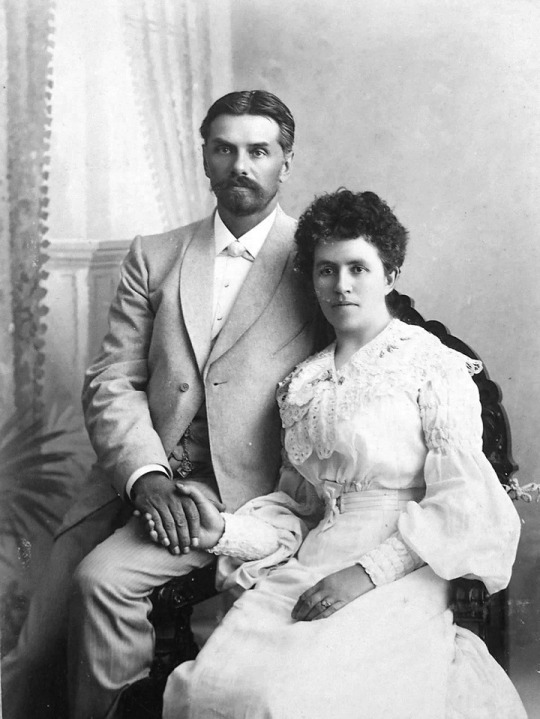
Maria with her husband, Ivan.
SOURCES:
The woman who photographed the Imperial Family in Tobolsk by Paul Gilbert
Thirteen Years at the Russian Court by Pierre Gilliard
#q#ask#answered#OTMA#Romanovs#Romanov family#Tobolsk#Freedom House#Exile#Captivity#Eugene Botkin#Evgeny Botkin#Anna Demidova#Pierre Gilliard#Alexandra Feodorovna#Maria Nikolaevna#sources#Thirteen Years at the Russian Court#my own
18 notes
·
View notes
Text



Grand Duchesses Olga Tatiana and Anastasia playing around with each other while Countess Anastasia Hendrikova watches gleefully!
The Finnish skerries 1912-13
#ohh Nastya 😩#shes sitting on her! 😂#anastasia nikolaevna#tatiana nikolaevna#olga nikolaevna#anastasia hendrikova#romanovs#romanovs being funny#early 1900s#imperial russia#finland
40 notes
·
View notes
Text

Grand duchesses Maria and Anastasia (in white) kissing Countess Anastasia Hendrikova during captivity at Tsarskoe Selo 1917
2 notes
·
View notes
Photo
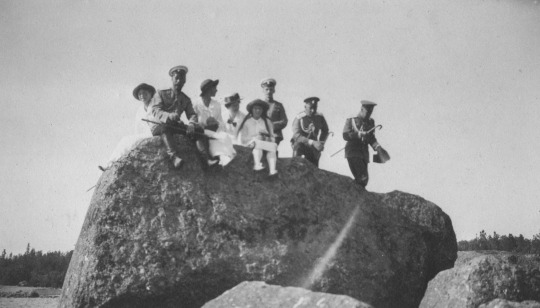
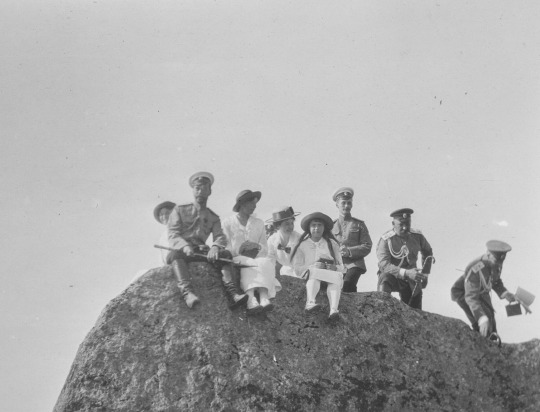
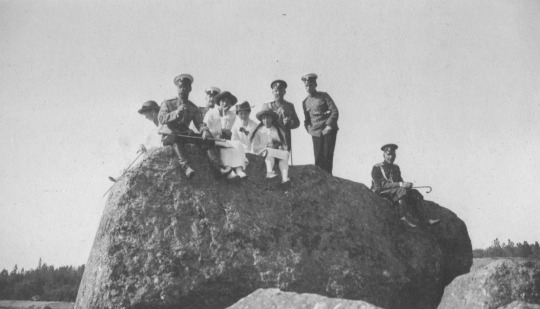

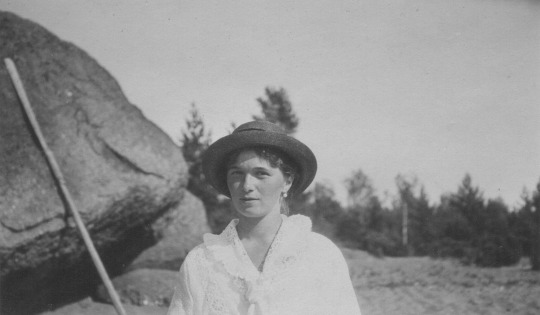
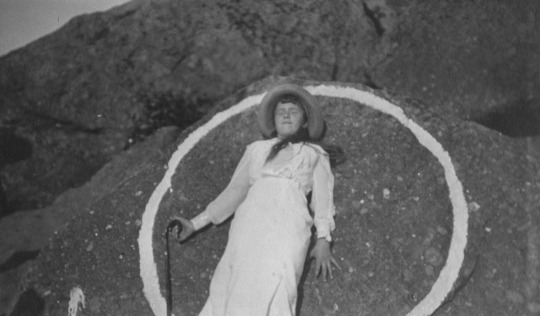
3rd July 1914
Photo 1-3 : Grand Duchess Olga Nikolaevna, Tsar Nicholas II, Grand Duchess Tatiana Nikolaevna, Countess Anastasia Hendrikova, Grand Duchess Anastasia Nikolaevna, Hippolyte Mikhailovich Mochalov, Count Alexander Nikolaevich Grabbe and an unknown officer, on Padio-Sari, 3rd July 1914.
Photo 4 : Grand Duchess Anastasia Nikolaevna, Vladimir Konstantinovich Molokhovets, Grand Duchess Olga Nikolaevna and Georgiy Nik. Taube on Padio-Sari, 3rd July 1914.
Photo 5 : Grand Duchess Olga Nikolaevna on Padio-Sari, 3rd July 1914.
Photo 6 : Grand Duchess Anastasia Nikolaevna on Padio-Sari, 3rd July 1914.
"3rd July. Thursday.
In the morning, went boating with Papa, Olga on the steering wheel. Boat learning. Kern on barge N°1, Taube N°2, Molokhovets on [?], N.N. on [?]. Had breakfast, drank tea and had dinner with everyone. In the afternoon, went for a walk on Padio-Sari. It was very warm. N.N. was not there. After tea sat with N.N., after dinner, at first in the wheelhouse, where Olga, Molokhovets, Kern and Taube were still sitting, then on the deck with N.N. It was terribly good."
(1914 Diary of Grand Duchess Tatiana Nikolaevna)
Photos from:
Grand Duchess Olga Nikolaevna's 1914-1915 Album
Grand Duchess Maria Nikolaevna's 1914 - 1916 Album
Anna Vyrubova's Album n°3
#Olga Nikolaevna Romanova#Tatiana Nikolaevna Romanova#Anastasia Nikolaevna Romanova#Nicholas II#Count Alexander Nikolaevich Grabbe#Countess Anastasia Hendrikova#Padio sari#OTA#Georgiy Nikolaevich Taube#Vladimir Konstantinovich Molokhovets#1914
45 notes
·
View notes
Photo




Photo 1 : Grand Duchess Anastasia Nikolaevna and Countess Anastasia Hendrikova "Nastenka" onboard the Standart, 1st July - 5th July 1914.
Photo 2-4 : Grand Duchess Anastasia Nikolaevna onboard the Standart, 1st July - 5th July 1914.
Photos from:
Grand Duchess Anastasia Nikolaevna's 1914-1915 Album
Grand Duchess Maria Nikolaevna's 1914 - 1916 Album
50 notes
·
View notes